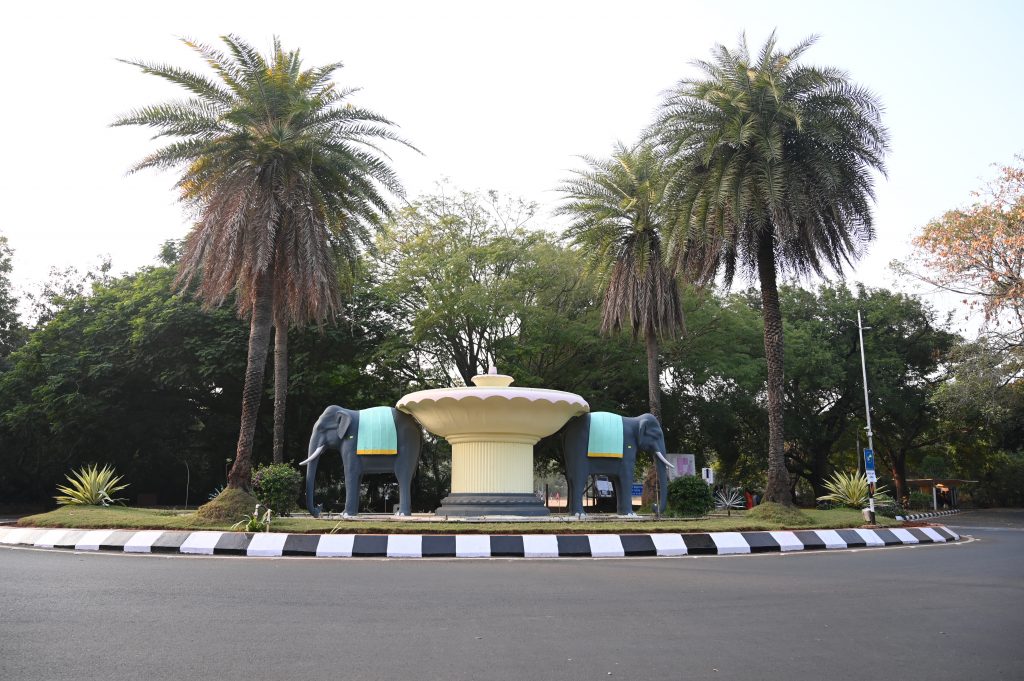They have been around for over 61 years. Yet, there is very little that is known about the two elephant statues of the Gajendra Circle, a landmark of IIT-Madras that represents what the institution stands for
Srivatsan S
A 15kmph slow drive — or 7kmph speed walk — under a canopy of overhanging trees of IIT-M can never be not energising. After the long roads that might look longer until about two kilometers from the main gate from Adyar, stand two elephants — separated by a fountain that looks like an inverted umbrella from a bird’s-eye view — facing opposite directions, refusing to confront or look into each other’s eyes like a passive-aggressive husband and wife after fighting over some silly domestic chores.
These elephants, whose once-dark coloured skin would glow during the sunkissed season of Chennai’s kathiri, are all now coin grey in color perhaps due to aging — or global warming. Imagine standing under the scorching Sun for 61 years! The IITians know it as Gajendra Circle; for others, it’s just a fascinating piece of art. 
The Gajendra Circle (GC) is the heart and epicenter of IIT Madras. Quite literally. If GC is the beating heart, then the arteries and veins are four connecting roads — Bonn and Delhi Avenue that run in parallel leading to the residential area, and newer ones such as Hostel and Alumni Avenue that lead to the hostel and academic areas respectively.
The two magnificent creatures are the first ones to welcome the fresh batch of students at the turn of every year. And this imposing structure, which has been the symbol of IIT-M and a landmark location in the campus, is perhaps the last stop where graduates gather for a quick selfie, or memorable ‘photograph’ as once it was known, before it’s pack up time. The short interval that remains in-between is the life of an IITian.
Mind you. For some, GC might only trigger memories of date nights and brewing romances they might have had. We are looking at you, alumni. Tsk. Tsk.

A snatch of history
At one point, the popularity of GC outside the campus was such that it even featured in ‘know your city’ guides for tourists as among the two places to check out in Adyar; the other one being the Banyan Tree in Theosophical Society. Despite all this, very little information is available in the public domain, and very little has been written about the origin of Gajendra Circle, which is synonymous with everything IIT-M stands for. 
Here’s how the story goes: Prof B Sengupto, the first Director of IIT-M, was the man behind the conception of the campus and the infrastructure the institution needed: hostels, laboratories, quarters and buildings; Sengupto saw to it that the majority of work was completed by the time his tenure ended. The Gajendra Circle, however, did not originate from him; it was the brainchild of R Natarajan, the first Registrar of IIT-M.
It was Natarajan, in fact, who coined the name Gajendra Circle. He was always fond of Bengaluru, which had so many ‘circles’ such as Narasimharaja Circle and something as recent as Anil Kumble Circle. “I told Prof Sengupto and our engineer that we should install two big elephants and call it Gajendra Circle. And it caught fire immediately among students,” said R Natarajan, in a conversation with Prof Ajit Kolar.
Not just GC, but all the avenues — Bonn, Madras and Delhi — were coined by him. “Charles Dickens wrote A Tale of Two Cities. Likewise, our campus is a handiwork of three cities: Bonn, Madras and Delhi,” said Natarajan, who was with IIT-M for six-and-a-half years till 1965. But the Gajendras we see today have not always looked the same.

Let’s first address the elephant in the room: the ‘circle’ in Gajendra is a lie; the structure isn’t ‘circular’ but oval. The first version of GC, which was primarily a lamp post with four lamps, came into existence in 1962. It had a figurine of the elephant head with its trunk pointing upwards as if to signal blessing or greeting, and was attached on each lamp post. This version continued to exist till the late ‘60s.
The second version of GC, installed roughly around 1967, looked even grander with an ambitious design: instead of four elephant heads, it was brought down to two life-sized elephants separated by a fountain and accompanied by two students on either side. One of the students carries a hammer in his hand, while the other holds the degree in hand.
The idea was to signify the journey of a student at IIT-M. But it didn’t go down well with students and the jokes kept coming. For instance, R Shankar, wrote in the students-run newspaper Campustimes, “Leaning on these two elephants are two men, who, like the elephants, have taken a natural and inevitable dislike to each other and are using the elephant’s head to hide from each other. What do these statues actually represent? Some say that the men represent the student body while the elephants represent the staff.”
The third and final version of GC, which was remodelled sometime in the early 1970s, is what we see today — without the accompanying boys. An imposing structure, Gajendra Circle is sometimes decked with colorful lights and the fountain is switched on during special occasions on campus — the only time elephants get to have their cold shower.
With inputs from IIT-M Heritage Centre. For more details, check out: https://heritage.iitm.ac.in/








